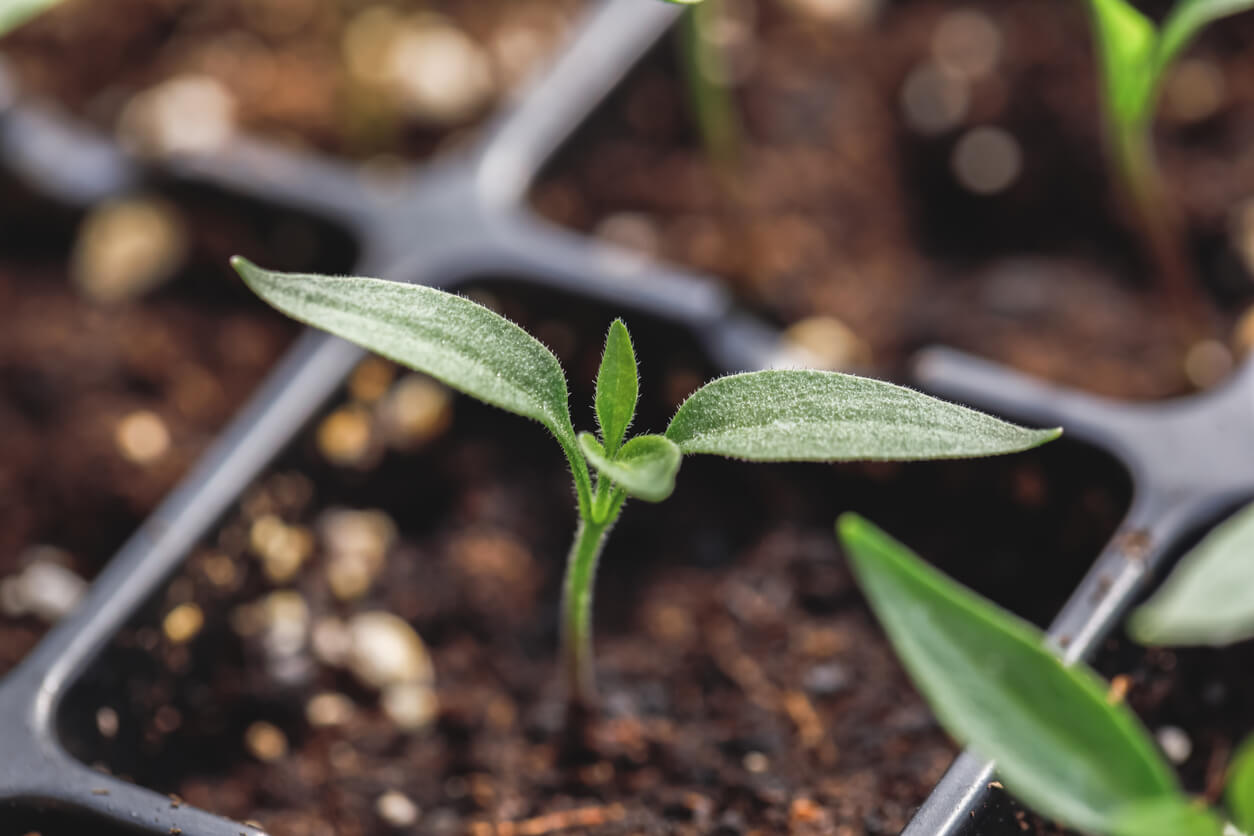
Chile pepper seedlings growing in seed starter tray
Peppers are warm-season perennials that we treat as annuals. They have a long growing season—15 to 18 weeks after planting out—and cooler weather slows them down. You can start them from seeds or seedlings, depending on your preference and your patience.
Seed Planting Process
Pepper seeds usually take a while to germinate; some can take up to four weeks or more. So check your calendar and plan ahead if you’re planning to start your pepper plants from seeds. Be sure to check the seed packets for the germination rate of the cultivar you’ve chosen.
Planting Seeds Indoors
Your best bet for successfully germinating hot pepper seeds is to do it indoors; even if you live in a warmer region, germinating your seeds indoors gives you more control over the conditions.
Ideally, you should start your seeds eight to 12 weeks before the last frost date. Again, be sure to check the germination time on your particular cultivar.
Use a heat mat to give the seeds the extra TLC they need, and be sure to keep the soil moist but not wet. The plastic cover that comes with seed trays will do the trick.
Now, for super-hot pepper seeds, you might want to try something called seed priming. Before starting, wash your hands and put on latex or vinyl gloves so you don’t transfer any contaminants to the seeds. Ideally, you should soak the seeds in a 50-50 mixture of filtered water and hydrogen peroxide for five minutes; this will help kill any bacteria that’s present.
Then, using what’s commonly called the paper towel method, put your seeds onto a damp paper towel that you then seal in a zippered plastic bag. Leave some air in the bag so the seeds have oxygen; you’re basically creating a miniature greenhouse. Put the bag on top of a heat mat. It’s a good idea to put a towel between the bag and the heat mat to promote even temperature. When the seeds germinate, put them into fresh potting soil. Cover the seeds with soil and press down slightly. Keep them watered (but not waterlogged) and make sure the area has adequate ventilation.
Once your seedlings emerge, they are going to need plenty of light. Turn on grow lights about 4 inches above your seedlings. Leave the lights on for 14 to 16 hours, and off for up to eight hours. Don’t leave the lights on 24/7; most plants need a little darkness to grow. Keep the lights over the seedlings, but not too close; you want to avoid burning the leaves. A distance of about a foot should do.
Once your seedlings begin to grow, you’ll want to harden them off before you transplant them to your garden. About three to four weeks after you plant the seeds, give your new seedlings a little sheltered outside time. Start with an hour or two a day in indirect sunlight, and progress to a full day outside. Bring your seedlings in for the night after each outdoor foray. This process helps strengthen the plant’s cells, giving them a better chance of thriving when you transplant them. Your seedlings should be about 8 to 12 inches tall before you consider planting them out.
Your garden soil temperature should be at least 50 degrees F before you set your seedlings out. When your seedlings are ready for the outdoor garden, have planting holes prepared for them. Pop the seedlings out of their little containers and put them right into their outdoor home. Don’t disturb the soil or root ball; the less you fuss with them, the better.
Cover the roots and attached soil with fresh garden soil and give them a good drink of water. If you’re concerned about pests moving in on your young plants, put a row cover over them.
Sowing Directly in the Garden
Gardeners who live in USDA Plant Hardiness Zone 8 and above have the luxury of direct sowing their pepper seeds once the ground is warm and not too wet. Nighttime temperatures need to be above 50 degrees F. The ideal range of nighttime temperatures is between 60 to 70 degrees F. Daytime temperatures should be warm and sunny. But be forewarned: even the most skilled gardeners have difficulty growing hot peppers using the direct sow method.
Hot pepper seeds can take anywhere from 14 to 30 days to germinate. Keep the soil moist, but drained. When your plants are 2 to 3 inches tall, thin them to 18 to 24 inches apart.
Have you tried growing hot peppers from seeds or seedlings? Which method do you prefer—and why? Please share your experiences with us.


 Previous
Previous


Regarding the placement of the grow light, This is what your article said, “Once your seedlings emerge, they are going to need plenty of light. Turn on grow lights about 4 inches above your seedlings. Leave the lights on for 14 to 16 hours, and off for up to eight hours. Don’t leave the lights on 24/7; most plants need a little darkness to grow. Keep the lights over the seedlings, but not too close; you want to avoid burning the leaves. A distance of about a foot should do.” So do I keep the light at 4 or 12 inches?